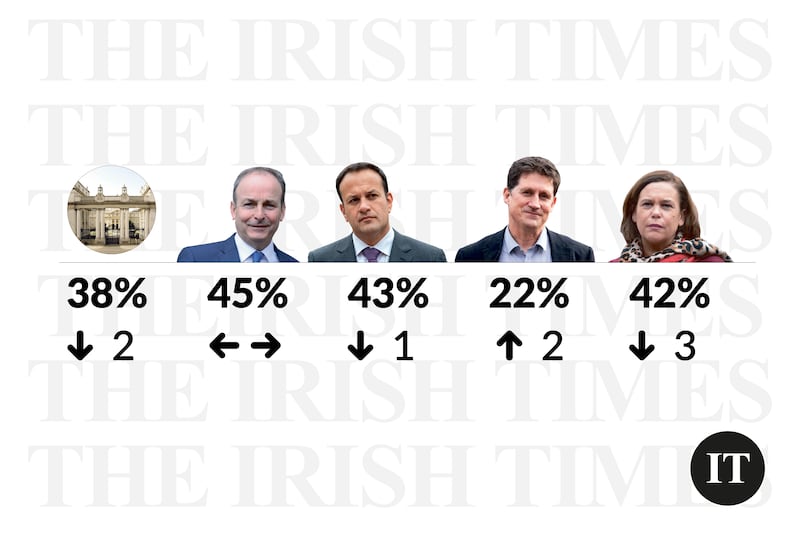The latest Irish Times/Ipsos poll confirms Sinn Féin as the most popular political party in Ireland, being the preferred choice of more than one in three voters (35 per cent).
Fine Gael (on 22 per cent) are four points ahead of Fianna Fáil (on 18 per cent), and both are some distance ahead of the chasing pack of Labour (on 4 per cent) and the Green Party (on 4 per cent).
The Independents/Others grouping combines to attract 18 per cent of the vote. Within this group are the Social Democrats (on 2 per cent) and People Before Profit-Solidarity (on 1 per cent).
These poll findings are remarkably consistent with the most recent Irish Times/Ipsos poll conducted in October last year, with no movement detected for Sinn Féin, Fine Gael or Labour. For other parties the change is marginal, with just a one-point difference recorded: the one exception is Fianna Fáil, who have dropped three points, from 21 per cent to 18 per cent.
Irish Times poll: Dubliners and farmers an unlikely pair in resisting radical change
Irish Times poll: Fianna Fáil-Fine Gael the most popular choice for new coalition
Election 2024: TV debate assumes outsize importance in uncertain race
The Irish Times view on the latest opinion poll: the race tightens entering the last lap

Fieldwork for today’s poll took place between Sunday and Tuesday of this week, among a representative sample of 1,200 eligible voters. In-person interviews were conducted in every county and in every constituency to provide a fully national picture of public opinion.
The announcement by the Government of a new cost-of-living package was made on Tuesday, the last day of fieldwork for this poll and after a majority of interviews had been completed. The announcement by the Social Democrats that a leadership election will be held was made after fieldwork had ended.
The backdrop to this latest poll is an economy in rude good health and a public struggling to cope with rising prices.
Ireland’s economic performance in 2022 was spectacular relative to other EU countries. Headwinds in the form of Brexit, a pandemic, sky-high energy prices, tech redundancies and higher interest rates – which have derailed other economies – had too little puff to blow our economy off track.
Of course, GDP growth does not automatically translate into a better quality of life for voters. Wages are not keeping up with the cost of living for many, or even most, Irish voters. Buying or renting a home is still a struggle. The health service is frequently overwhelmed. Growing pains no doubt, but are the pains and the gains shared evenly?
The gap between the macro-economic picture and the lived experience of some voters is a space in which Sinn Féin has thrived. Recent Irish Times/Ipsos polls suggest Sinn Féin has consolidated its number one position, registering a double-digit lead in each of our last six polls.
While Sinn Féin maintains a young, working-class profile (62 per cent of voters are under 50, and 62 per cent are from blue-collar backgrounds), the party had made gains across all demographic cohorts in recent years. This is nowhere more evident than among middle-class voters, where Sinn Féin’s vote share is now 30 per cent, ahead of Fine Gael (on 27 per cent) and Fianna Fáil (on 16 per cent).

Fine Gael (on 22 per cent) appears to have gained the upper hand on Fianna Fáil (on 18 per cent) for the time being at least. What has been a close contest between the two parties at the total electorate level hides some very stark differences within voter sub-groups. Among the under-35s, Fine Gael has almost twice the level of support – 17 per cent compared to 9 per cent for Fianna Fáil. Among the professional/higher managerial socio-economic grouping (ABs), the gap in favour of Fine Gael is wider still – 35 per cent versus 13 per cent for Fianna Fáil.
Fianna Fáil outpolls Fine Gael in the Rest of Leinster region, among 65 plus year olds and those from farming backgrounds, but in each instance the advantage is relatively modest.
It may be the case that Bertie Ahern rejoining the Fianna Fáil party has shaved a few points off the party’s vote or it could just be coincidental. What we do know is support for Fianna Fáil, at 18 per cent, is at a two-year low in The Irish Times/Ipsos series of polls.
Poll trends point to something of a revolving door between Fianna Fáil and Independents. If Fianna Fáil are down in a poll, the likelihood is that Independents are up. Consistent with this dynamic, support for the Independents/Other grouping is higher by two points (up to 18 per cent) in this latest poll.
Swapping seats at the head of the Cabinet table has not had a noticeable impact on party leader ratings. Satisfaction with the performance of now Taoiseach Leo Varadkar is at 43 per cent (down one point), while stepping down to the role of Tánaiste has had no impact on Micheál Martin’s rating which is unchanged on 45 per cent. A relatively seamless transition in the opinion of voters.
Satisfaction with the leader of Ireland’s largest party, Mary Lou McDonald, has slipped somewhat, down three points to 42 per cent.
A week may be a long time in politics, but little has changed over the past two years in terms of how the electorate expects to vote in the next general election. The Fine Gael and Fianna Fáil faithful are holding firm, while the floating voter continues to swell the ranks of Sinn Féin. This steady state may hold until the next General Election, although change usually happens when we least expect it.



